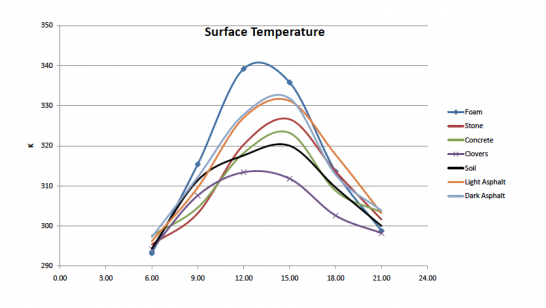Abstract
The goal of this experiment was to measure and calculate the energy flux components over various man-made and natural surfaces. The measurements were performed six times in one day, every three hours (at 0600, 0900, 1200, 1500, 1800 and 2100 hours) in order to try to capture the diurnal cycle of the energy flux. In order to minimize scatter and get consistent results, the weather on the day of the experiment had to be clear and cloudless.
The instruments that we used are: Eppley pyranometer (incoming and outgoing shortwave radiation), Raytek infrared gun (surface temperature), Kestrel handheld weather meter (air temperature, wind speed, humidity) and a portable spectrometer (incoming and outgoing radiation as a function of wavelength). Due to limited measuring equipment, sensible heat flux and latent heat flux had to be parameterized.
The heat budget experiment produced results that were in accordance with theoretical expectations: All of the energy components show a diurnal cycle which is directly related to solar insolation cycle. Largest inaccuracies were found in values of turbulent heat flux (sensible and latent heat flux), most likely due to errors introduced through parameterizations. Albedo was also measured as a part of the experiment. As expected, visually brightest surface (concrete) had the highest albedo and consequently lower surface temperatures.
Write-up Document
Mini Project writeup by Dea Doklestic, Aaron Judah and Tamara Machac
Presentation
Presentation on July 14th: Mini Heat Budget Experiment in Aug, 2009
